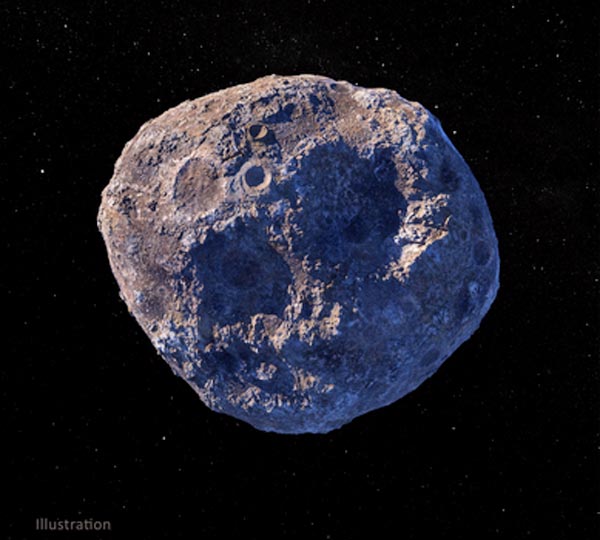Computer simulation models potential asteroid collisions

NASA’s Psyche mission aims to be the first spacecraft to explore an asteroid made entirely of metal.
Credit: NASA/JPL-Caltech/ASU
Results to provide data for NASA’s upcoming Psyche mission.
An asteroid impact can be enough to ruin anyone’s day, but several small factors can make the difference between an out-of-this-world story and total annihilation. In AIP Advances, by AIP Publishing, a researcher from the National Institute of Natural Hazards in China developed a computer simulation of asteroid collisions to better understand these factors.
The computer simulation initially sought to replicate model asteroid strikes performed in a laboratory. After verifying the accuracy of the simulation, Duoxing Yang believes it could be used to predict the result of future asteroid impacts or to learn more about past impacts by studying their craters.
“From these models, we learn generally a destructive impact process, and its crater formation,” said Yang. “And from crater morphologies, we could learn impact environment temperatures and its velocity.”
Yang’s simulation was built using the space-time conservation element and solution element method, designed by NASA and used by many universities and government agencies, to model shock waves and other acoustic problems.
The goal was to simulate a small rocky asteroid striking a larger metal asteroid at several thousand meters per second. Using his simulation, Yang was able to calculate the effects this would have on the metal asteroid, such as the size and shape of the crater.
The simulation results were compared against mock asteroid impacts created experimentally in a laboratory. The simulation held up against these experimental tests, which means the next step in the research is to use the simulation to generate more data that can’t be produced in the laboratory.
This data is being created in preparation for NASA’s Psyche mission, which aims to be the first spacecraft to explore an asteroid made entirely of metal. Unlike more familiar rocky asteroids, which are made of roughly the same materials as the Earth’s crust, metal asteroids are made of materials found in the Earth’s inner core. NASA believes studying such an asteroid can reveal more about the conditions found in the center of our own planet.
Yang believes computer simulation models can generalize his results to all metal asteroid impacts and, in the process, answer several existing questions about asteroid interactions.
“What kind of geochemistry components will be generated after impacts?” said Yang. “What kinds of impacts result in good or bad consequences to local climate? Can we change trajectory of asteroids heading to us?”
The article “Numerical modeling of laboratory-scale asteroid impact based on elastoplastic flow model and CESE method” is authored by Duoxing Yang. The article will appear in AIP Advances on Dec. 21, 2021 (DOI: 10.1063/5.0064441). After that date, it can be accessed at https://doi.org/10.1063/5.0064441.
ABOUT THE JOURNAL
AIP Advances is an open access journal publishing in all areas of physical sciences—applied, theoretical, and experimental. The inclusive scope of AIP Advances makes it an essential outlet for scientists across the physical sciences. See https://aip.scitation.org/journal/adv.
Journal: AIP Advances
DOI: 10.1063/5.0064441
Article Title: Numerical modeling of laboratory-scale asteroid impact based on elastoplastic flow model and CESE method
Article Publication Date: 21-Dec-2021
Media Contact
Larry Frum
American Institute of Physics
media@aip.org
Office: 301-209-3090
All latest news from the category: Physics and Astronomy
This area deals with the fundamental laws and building blocks of nature and how they interact, the properties and the behavior of matter, and research into space and time and their structures.
innovations-report provides in-depth reports and articles on subjects such as astrophysics, laser technologies, nuclear, quantum, particle and solid-state physics, nanotechnologies, planetary research and findings (Mars, Venus) and developments related to the Hubble Telescope.
Newest articles

NASA: Mystery of life’s handedness deepens
The mystery of why life uses molecules with specific orientations has deepened with a NASA-funded discovery that RNA — a key molecule thought to have potentially held the instructions for…

What are the effects of historic lithium mining on water quality?
Study reveals low levels of common contaminants but high levels of other elements in waters associated with an abandoned lithium mine. Lithium ore and mining waste from a historic lithium…

Quantum-inspired design boosts efficiency of heat-to-electricity conversion
Rice engineers take unconventional route to improving thermophotovoltaic systems. Researchers at Rice University have found a new way to improve a key element of thermophotovoltaic (TPV) systems, which convert heat…



